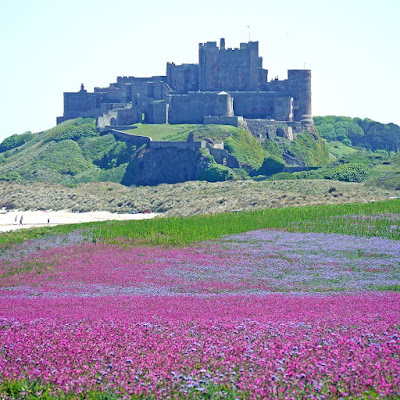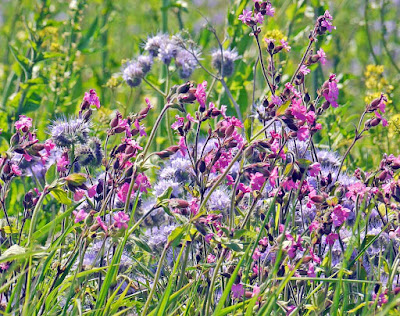Sunday, May 28, 2017
Blaze of colour
This field, at Bamburgh on the Northumberland coast, has been sown with wild and nectar rich flowers, as part of a wonderful EU Environmental Stewardship scheme to boost bumblebee numbers and to provide food for game birds like partridges.
Most of the colour that can be seen now is due to red campion and the blue-flowered Phacelia, but the colours will change through the season as other species come into flower.
Click here for pictures of a similar planting, with different species and on a smaller scale, in Norfolk.
Sunday, May 14, 2017
Red Grouse chicks
The heather moorland on Pikestone fell near Wolsingham in Weardale today was full of recently-hatched red grouse chicks.
When they are this small they have difficulty in running through the rough grass and forests of heather, so sometimes running across the top of the heather bushes is the easiest rout to safety.
The chicks are well camouflaged but when they know they have been spotted they make a run for it ....
.... and there is only one place they want to be ....
.... and that's with their mother.
This very protective hen bird has six chicks sheltering under her body and wings.
Labels:
red grouse
Thursday, May 4, 2017
Peak Bluebell
This was the scene this afternoon in Hollingside wood, about a mile south of Durham city centre.
On a mild, still spring day the scent was intoxicating. The 17th. century herbalist John Gerard, who knew these flowers as the English Jacinthe or Hare-Bel, thought it 'a strong, sweet smell, somewhat stuffing the head.....'
In The Englishman's Flora (1958) Geoffrey Grigson lists almost 50 county or regional names for bluebell, that include adder's flower, blue bonnets, blue bottle,crow-bells,, cuckoo's stockings, fairy bells, goosey-gander, griggles, pride of the wood, rook's flower and ring o' bells ..... but the one I like best, from Kent, is snapgrass, said to be derived 'from the rubbing, clicking noise of the stalks when gathered'.
The bulbs were once harvested to make glue.
This is how John Gerard described them, in The Herbal
or General History of Plants, published in 1633:
'.....the root is bulbous, full of a slimy glewish juyce,
which will serve to set feathers upon arrows instead of glew or to paste books
with.....'
Labels:
Bluebells,
Hyacinthoides non-scripta
Subscribe to:
Comments (Atom)









































